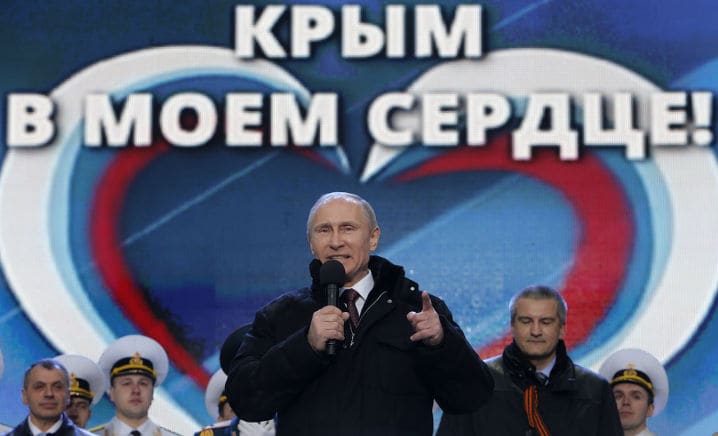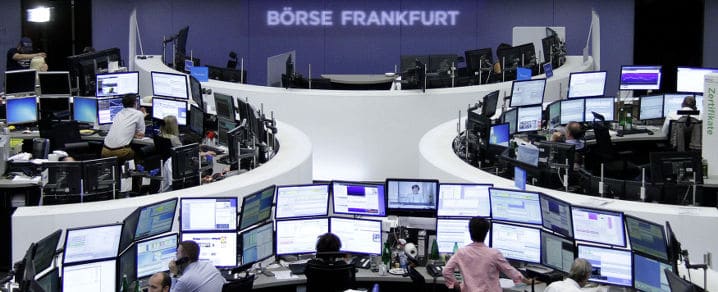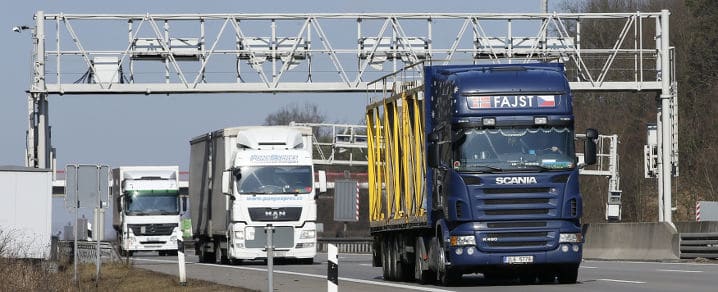Does Serbia Continue to Do Military Aggression Despite All the Sanctions
What is published in NATO Review does not constitute the official position or policy of NATO or member governments.
NATO Review seeks to inform and promote debate on security issues. The views expressed by authors are their own.
Sanctions after Crimea: Have they worked?
- Edward Hunter Christie
- 13 July 2015

Russia's President Vladimir Putin (front) addresses the audience during a rally and a concert called "We are together" to support the annexation of Ukraine's Crimea to Russia, with Crimea's Prime Minister Sergei Aksyonov and parliamentary speaker Vladimir Konstantinov (L) seen in the background, at the Red Square in central Moscow, March 18, 2014. The words in the background read, "Crimea is in my heart!". © Reuters
When Russia illegally annexed Crimea and started interfering in Eastern Ukraine, the West responded with economic sanctions. In July 2014, sanctions were enacted in a coordinated manner by the European Union, the United States, Canada, and other Allies and partners.
These sanctions were further strengthened in September 2014. EU sanctions, which had been due to lapse in July 2015, have been extended to January 2016. The US and Canadian sanctions are open-ended.
There are three types of economic sanctions. The first restricts access to Western financial markets and services for designated Russian state-owned enterprises in the banking, energy, and defence sectors. The second places an embargo on exports to Russia of designated high-technology oil exploration and production equipment. The third is an embargo on exports to Russia of designated military and dual-use goods.
The justification for these Western sanctions is internationally well-understood. But to muddy the waters, Russia imposed a ban on food imports from Western nations in August 2014. That ban remains in place.
After around a year of these sanctions and measures, what impacts can we see on both the Russian and European economies?
For the Russian economy, the sanctions are generally assessed to have helped exacerbate the macroeconomic challenges it was already facing, notably the rapid and pronounced fall in oil prices that started in the last months of 2014.
Recent data confirm Russia's entry into recession, with GDP growth of -2.2% for the first quarter of 2015, as compared to the first quarter of 2014
Furthermore, the combined effect of these sanctions and of the fall in oil prices caused significant downward pressure on the value of the Rouble and increased capital flight.
At the same time, the sanctions on access to financing forced the Russian state to use part of its foreign exchange reserves to shore up the sanctioned entities.
These developments forced the hand of the Central Bank of Russia, which abruptly ceased to defend the value of the Rouble and hike interest rates in December 2014.
Russia's ban on Western food imports had a compounding effect on this challenging picture, as it led to higher food prices and hence to further inflation. This was in addition to the effect of the fall in the value of the Rouble, which had already raised the price of imported goods and services in Roubles.
Recent data confirm Russia's entry into recession, with GDP growth of -2.2% for the first quarter of 2015, as compared to the first quarter of 2014. Recent forecasts suggest a fall in real GDP in the order of 3%-3.5% for 2015, and growth of around zero for 2016.

Traders are pictured at their desks in front of the DAX board at the Frankfurt stock exchange July 7, 2015. © Reuters
In sum, Western sanctions have been a success in terms of the proximate goal of inflicting damage on the Russian economy.
This comes in addition to the signalling value of the economic sanctions.
Western nations
- took coordinated action (signalling unity)
- against strategic entities of the Russian state (signalling attribution of responsibility)
- in a manner designed to cause concrete economic damage (signalling credibility)
- while accepting the (limited) risk that economic pain may befall them as a result (signalling resolve).
But have these sanctions had painful consequence for their initiators?
European economies are affected by the sanctions and by Russia's current recession principally through trade , i.e. by losses in export revenues.
Losses are caused:
- directly by Western sanctions (exports of oil-producing equipment and of military and dual-use goods);
- directly by Russia's food import ban;
- and indirectly due to Russia's recession and lower exchange rate, which together lead to much lower demand for imports (from anywhere in the world).
The latter, indirect effect is by far the largest, but it can only be partly attributed to Western sanctions – the lower oil price remains the dominant driver according to leading analysts.
TABLE 1 – Shifts in goods exports to Russia and to other countries – EU Member States
| REPORTER | Total exports in 2014Q1 (EUR mn) | Change in exports to Russia EUR mn) | Change in exports to other markets (EUR mn) | Net change (EUR mn) | Net change (% of 2014Q1) |
|---|---|---|---|---|---|
| Cyprus | 325 | -5 | 182 | 177 | 54.3% |
| Ireland | 21,107 | -78 | 3,717 | 3,639 | 17.2% |
| Bulgaria | 4,859 | -41 | 646 | 606 | 12.5% |
| Croatia | 2,364 | -21 | 254 | 233 | 9.9% |
| Poland | 40,223 | -521 | 3,811 | 3,291 | 8.2% |
| Czech Republic | 32,205 | -365 | 2,836 | 2,471 | 7.7% |
| Hungary | 20,433 | -165 | 1,633 | 1,467 | 7.2% |
| Malta | 536 | 0 | 37 | 37 | 6.9% |
| Denmark | 20,548 | -114 | 1,490 | 1,376 | 6.7% |
| Slovenia | 6,597 | -85 | 499 | 414 | 6.3% |
| Germany | 278,427 | -2,566 | 17,952 | 15,386 | 5.5% |
| Romania | 12,758 | -91 | 734 | 643 | 5.0% |
| Luxembourg | 3,618 | -14 | 177 | 163 | 4.5% |
| Portugal | 11,707 | -18 | 460 | 442 | 3.8% |
| EU Total | 1,143,317 | -8,652 | 49,019 | 40,367 | 3.5% |
| Spain | 60,276 | -301 | 2,358 | 2,057 | 3.4% |
| Italy | 96,151 | -668 | 3,708 | 3,040 | 3.2% |
| France | 109,586 | -612 | 3,667 | 3,056 | 2.8% |
| Slovakia | 16,194 | -156 | 547 | 391 | 2.4% |
| United kingdom | 96,345 | -333 | 2,599 | 2,266 | 2.4% |
| Austria | 33,037 | -360 | 497 | 137 | 0.4% |
| Netherlands | 125,648 | -590 | 988 | 398 | 0.3% |
| Belgium | 88,707 | -360 | 51 | -309 | -0.3% |
| Estonia | 2,854 | -147 | 132 | -15 | -0.5% |
| Sweden | 31,179 | -196 | -72 | -267 | -0.9% |
| Latvia | 2,589 | -87 | 55 | -33 | -1.3% |
| Greece | 6,379 | -24 | -81 | -105 | -1.6% |
| Finland | 13,248 | -358 | 23 | -336 | -2.5% |
| Lithuania | 5,415 | -374 | 118 | -256 | -4.7% |
Source: Eurostat trade statistics; 2015Q1 compared to 2014Q1; Extra-EU and Intra-EU trade.
For European Allies and Partners, recent data demonstrates that the losses incurred due to Russia's general economic downturn have been well contained.
Of course, exports to Russia have fallen substantially, on average by around one third when comparing the first quarter of 2015 with the first quarter of 2014. However Russia's importance as a destination market is quite limited for most European countries and, more importantly still, European businesses have been able to find new markets for their products, both within Europe and beyond – a phenomenon referred to by economists as trade diversion.
The analysis of trade diversion is an essential component of any serious analysis of the impacts of sanctions.
The analysis of trade diversion is an essential component of any serious analysis of the impacts of sanctions. This is shown in Table 1, again focusing on the change between the 1st quarter of 2014 (without sanctions, with a high oil price, and with Russia still growing), and the 1st quarter of 2015 (with sanctions, with a low oil price, and with Russia in recession). Table 1 displays the results for the 28 countries of the European Union.
Some 21 out of the 28 EU Member States experienced a net gain in exports to the world in spite of the Russian downturn, thanks to increases in exports to other markets (both within and beyond the EU) that more than compensated for the falls in exports to Russia. The same is true for the European Union in the aggregate, with exports to Russia falling by 8.65 billion Euros, but exports to other destinations increasing by 49.02 billion Euros (including intra-EU trade).

A man stands next to a building under a board showing currency exchange rates in Moscow, December 16, 2014. © Reuters
It is also interesting to note that, apart from the three Baltic states, all the other Central and Eastern European Member States were able to more-than-compensate for the losses related to Russia (notably because their exposure to the Russian market was not especially high to begin with). The same is true for Southern EU Member States, leaving the special case of Greece aside (see below), and for all of the large EU economies, most notably Germany and Italy, countries that are often portrayed as having significant economic linkages with Russia. What these official trade statistics clearly prove today is that Russia can undergo a severe recession, and be saddled with a robust sanctions regime, without causing any net export losses to these countries.

European businesses have been able to find new markets for their products, both within Europe and beyond – a phenomenon referred to by economists as trade diversion. © Reuters
There are, however, 7 EU Member States that have experienced net losses. These countries naturally split into two groups: those that were able to expand into new markets, but to an insufficient degree; and those who experienced losses on both counts, i.e. from the Russian market and from other markets. Sweden and Greece are the only countries to have experienced both types of losses, signifying a general loss of export competitiveness which is
notdue to the Russian downturn. Belgium, Estonia, Latvia, Finland, and Lithuania belong to the former category.
As for the size of the total net losses, only Lithuania and Finland can be seen as relatively severe cases, i.e. where the losses in export revenues would be expected to have a significant impact on GDP growth. On that count, however, only Finland seems to be experiencing disappointing macroeconomic results, while Lithuania remains on a robust growth trajectory thanks to strong domestic demand.
As the European economy overwhelmingly shrugs off the effects of Russia's recession – which is only partly caused by sanctions – Western Allies should take comfort in the knowledge that pursuing a strong and principled sanctions policy appears eminently affordable. The evidence indicates that the doomsayers have been proved wrong.
morrisonwhicagoers.blogspot.com
Source: https://www.nato.int/docu/review/articles/2015/07/13/sanctions-after-crimea-have-they-worked/index.html
Post a Comment for "Does Serbia Continue to Do Military Aggression Despite All the Sanctions"